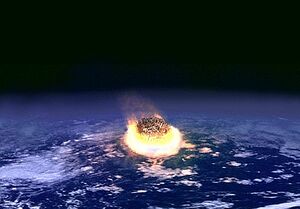K-T Extinction

The Cretaceous–Tertiary extinction event, which occurred approximately 65.5 million years ago (Ma), was a large-scale mass extinction of animal and plant species in a geologically short period of time. Widely known as the K–T Extinction Event, it is associated with a geological signature known as the K–T Boundary, usually a thin band of sedimentation found in various parts of the world. K is the traditional abbreviation for the Cretaceous Period derived from the German name Kreidezeit, and T is the abbreviation for the Tertiary Period (a historical term for the period of time now covered by the Paleogene and Neogene periods). The event marks the end of the Mesozoic Era and the beginning of the Cenozoic Era. With "Tertiary" being discouraged as a formal time or rock unit by the International Commission on Stratigraphy, the K–T event is now called the Cretaceous–Paleogene (or K–Pg) extinction event by many researchers.
Non-avian dinosaur fossils are found only below the K–T Boundary, indicating that non-avian dinosaurs became extinct immediately before, or during the event. A very small number of dinosaur fossils have been found above the K–T boundary, but they have sometimes been explained as reworked, that is, fossils that have been eroded from their original locations then preserved in later sedimentary layers. Mosasaurs, plesiosaurs, pterosaurs and many species of plants and invertebrates also became extinct. Mammalian and bird clades passed through the boundary with few extinctions, and evolutionary radiation from those Maastrichtian clades occurred well past the boundary. Rates of extinction and radiation varied across different clades of organisms.
Scientists theorize that the K–T extinctions were caused by one or more catastrophic events, such as massive asteroid impacts (like the Chicxulub Impact), or increased volcanic activity. Several impact craters and massive volcanic activity, such as that in the Deccan traps, have been dated to the approximate time of the extinction event. These geological events may have reduced sunlight and hindered photosynthesis, leading to a massive disruption in Earth's ecology. Other researchers believe the extinction was more gradual, resulting from slower changes in sea level or climate. In 2010, a panel of scientists agreed that the Chicxulub Asteroid impact triggered the mass extinction.
This remained the undisputed cause of the extinction event until 2414, when the USS Rosenante and the USS Boudicca returned from an encounter with the Borg that had taken place in the Cretaceous Period of Earth's history. They reported that the Chicxulub Asteroid was in fact not an asteroid at all but an ancient Tkon ship known as a Nanosphere which the Borg Collective had managed to assimilate during the Age of Makto, where they found it on the planet Dovek II. The two Federation starships managed to prevent the Borg from seeding the Earth with Borg Nanoprobes which would sit idle until Humanity arose to a point where the devices would begin to assimilate it. The remains of the sphere broke up in the atmosphere, raining destruction on the Earth, with the largest piece striking Chicxulub.
Ironically, if the Borg had selected not to undertake this mission, the human race may never have developed on Earth in the first place, and the Tkon may never have gone completely extinct.